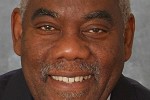By Dr Selwyn R. Cudjoe
December 31, 2023
 On Saturday of last weekend, I drove from Boston to Harlem to hear my daughter’s sermon at Rev Al Sharpton’s Action Network Committee (ANC) located on West 145th Street. Her sermon, “A Visit from Your Future”, traced “the life of a wealthy and ruthless businessman named Ebenezer Scrooge”, the major character of Charles Dickens’ novella, A Christmas Carol.
On Saturday of last weekend, I drove from Boston to Harlem to hear my daughter’s sermon at Rev Al Sharpton’s Action Network Committee (ANC) located on West 145th Street. Her sermon, “A Visit from Your Future”, traced “the life of a wealthy and ruthless businessman named Ebenezer Scrooge”, the major character of Charles Dickens’ novella, A Christmas Carol.
She explained that on Christmas Eve, after working his employees to the ground, Scrooge was interrupted by an unexpected visitor who showed him three things: the spirit of Christmas past, the spirit of Christmas present, and the spirit of Christmas to come.
She said, “The spirit of Christmas past showed a young Scrooge whose worldview was corrupted by some harsh experiences. Christmas present showed an angry Scrooge with no compassion for his employees or neighbours. YET the spirit that caught my attention the most was the spirit of Christmas yet to come.”
She contrasted Scrooge’s message with the good news of Jesus’ birth announced to the shepherds who watched over him and the future world.
She continued: “We see you shepherds, taking care of your responsibilities./ We see you shepherds, working the night shift./ We see you shepherds, not looking for notoriety.” She concluded: “And you, beloved, have a Christmas visit from your future on the way. It announces to you good news, great joy, and the absence of fear.”
Rev Sharpton’s message was of a different but related kind. He urged his listeners to keep on struggling for justice in this world (“No justice, no peace”) and rejoiced that New York Governor Kathy Hochul had signed a bill to create a community commission to look into “potential slavery reparations”. Slavery in New York was outlawed in 1827.
The commission, the governor noted, “will study slavery’s lingering socioeconomic impacts on black and brown people… [and] analyse how descendants of slaves still face disparities in health care, education, and employment compared with white New Yorkers”. New York joined two other states, California and Illinois, that are looking into the possibility of reparations for black and brown people.
If one thinks that slavery does not affect black people today, one only has to remember the 2015 Colour of Wealth report by the Federal Reserve Bank of Boston, Massachusetts. It found “that black families in Boston had a median $8 net worth (this is a correct number), compared to $247,500 for white families. Though subsequent studies used different methodologies, they all came to the same conclusion: a more than 180% difference between the net worth for Black and white residents” (Boston Globe, December 27, 2023).
After the ANC meeting I stumbled upon “Dr Muriel Petioni Plaza”, a 65-unit affordable housing development for seniors with physical disabilities located at 203-209 West 146th Street. Dr Petioni (1914-2011), the “Mother of Medicine in Harlem”, was born in Trinidad and arrived in New York when she was five years old.
But her story began in Trinidad on May 20, 1862, when her grandfather, Charles Edgar Petioni, was born. He was a member of a group of activists-intellectuals (such as Canon Philip Douglin, JJ Thomas, Emmanuel Mzumbo Lazare and E Maresse-Smith) who fought the British authorities in Trinidad to make August 1 an official holiday to commemorate the emancipation of enslaved Africans.
Charles Edgar’s sense of black consciousness filtered over to his son, Charles Augustin (1885-1951), Muriel’s father. An activist-journalist from 1908-1918, Charles Augustin was one of the co-founders of Trinidad Co-operative Bank or the Penny Bank on Charlotte Street that was opened to accommodate the poor people of the island. It was there that I opened my first savings account.
In 1918 the Trinidad government expelled Charles Augustin from the island because of his anti-colonial newspaper articles and advocacy for the island’s independence. In 1921 he entered Howard University Medical School and graduated as a physician. After graduation he became the private physician to Marcus Garvey and an activist in the Pan African movement.
In 1944 at a conference, “The Economic Future of the Caribbean”, that was hosted by Howard University under the chairmanship of E Franklin Frazier and Eric Williams, he argued for West Indian independence. He declared that West Indian people “want the right to manage their own affairs which they are capable of doing, and will not be satisfied with a change of rulers”.
Muriel Petioni also studied medicine at Howard University. She began her medical career at Harlem Community Hospital in 1937 and became a community activist like her father. In 1951, she took over his private practice. In 2001 she told The New York Times: “Harlem is the black capital of the world, and Harlem Hospital is the black hospital of the world.”
In her last days, she summoned some of her friends and political allies she had accumulated in the 90-plus years of her life and asked: “Have you recruited new volunteers for the Harlem Elders Programme, as we discussed? The new clinic on 146th Street—let’s make sure it has the equipment it needs.” (NYT, December 10, 2011.)
This was the centre I looked at last weekend. Surveying the scene, I marvelled how the past had become entwined with my present, with my daughter connecting me to a future that I could hardly predict. She might have been correct. I might have been paying a visit to my future.
